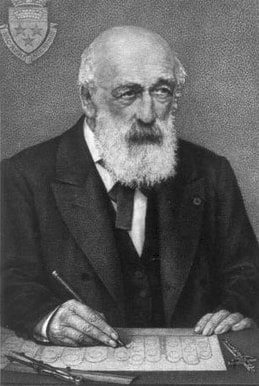Pugin, Bethune, and the Gothic Revival in France
Note that within this section we would like to include information and photos on other Society events. Please contact Catriona Blaker if you have items to contribute regarding past outings.

This year's study tour, from 21-25 August, visited the historic city of Lille, capital of French Flanders, to explore the relationships between two great exponents of the gothic revival, Baron Bethune and Augustus Pugin.
Jean-Baptiste Bethune (1821-1894), sometimes termed the Belgian Pugin, was one of the major figures in the development of the gothic revival in Belgium and northern France. He first encountered the writings of A.W.N. Pugin when he was a student at the University of Leuven; and he shared his passionate belief in revival of the Christian art. The two architects met at least four times both in England and Belgium. In 1850 Bethune visited Pugin in his home in Ramsgate, spending two days discussing publications and design. He travelled to Birmingham to stay with Hardman, where he viewed the Hardman works, as well as visiting key sites such as Alton Towers, St Giles’s Cheadle and Ushaw. He developed productive relations with Hardman and with Augustus’s son Edward, with whom he worked on the Basilica at Dadizele. Bethune drew on English influences in the formation of the Schools of St Luke, an important influence in shaping the gothic revival in Belgium.
We arrived in Lille via Eurostar to stay in the Hotel Brueghel, a three-star hotel housed in a nineteenth century building in the heart of the old town. We were fortunate in having as our guide over the four days, Dr Gilles Maury, from the Department of Architecture at the University of Lille, who is an expert on the work of Bethune and the gothic revival. An old friend of the Society, he has written on the complex relationship between Pugin and Bethune.
Throughout the four-day study tour, we took an architectural walk around the centre of the old town of Lille, exploring its seventeenth century brick town houses, paved streets, and Grand Place, in addition to later nineteenth century developments, including the ‘new’ cathedral (1855-1999), and the catholic University buildings (from 1875). In the former textile town of Roubaix, we visited Bethune’s magnificent St Joseph’s church and his convent of Clarisses, both deeply influenced by Pugin’s work. We also saw the Musée La Piscine, with its nineteenth and twentieth century art and design collections, housed in a former art deco swimming pool. We visited E.W. Pugin’s superb basilica of the Immaculate Conception at Dadizele, one of his largest and most impressive churches, where he worked jointly with Bethune. In all, a most wonderful and instructive trip.
Jean-Baptiste Bethune (1821-1894), sometimes termed the Belgian Pugin, was one of the major figures in the development of the gothic revival in Belgium and northern France. He first encountered the writings of A.W.N. Pugin when he was a student at the University of Leuven; and he shared his passionate belief in revival of the Christian art. The two architects met at least four times both in England and Belgium. In 1850 Bethune visited Pugin in his home in Ramsgate, spending two days discussing publications and design. He travelled to Birmingham to stay with Hardman, where he viewed the Hardman works, as well as visiting key sites such as Alton Towers, St Giles’s Cheadle and Ushaw. He developed productive relations with Hardman and with Augustus’s son Edward, with whom he worked on the Basilica at Dadizele. Bethune drew on English influences in the formation of the Schools of St Luke, an important influence in shaping the gothic revival in Belgium.
We arrived in Lille via Eurostar to stay in the Hotel Brueghel, a three-star hotel housed in a nineteenth century building in the heart of the old town. We were fortunate in having as our guide over the four days, Dr Gilles Maury, from the Department of Architecture at the University of Lille, who is an expert on the work of Bethune and the gothic revival. An old friend of the Society, he has written on the complex relationship between Pugin and Bethune.
Throughout the four-day study tour, we took an architectural walk around the centre of the old town of Lille, exploring its seventeenth century brick town houses, paved streets, and Grand Place, in addition to later nineteenth century developments, including the ‘new’ cathedral (1855-1999), and the catholic University buildings (from 1875). In the former textile town of Roubaix, we visited Bethune’s magnificent St Joseph’s church and his convent of Clarisses, both deeply influenced by Pugin’s work. We also saw the Musée La Piscine, with its nineteenth and twentieth century art and design collections, housed in a former art deco swimming pool. We visited E.W. Pugin’s superb basilica of the Immaculate Conception at Dadizele, one of his largest and most impressive churches, where he worked jointly with Bethune. In all, a most wonderful and instructive trip.
Booking: please send cheques payable to The Pugin Society, and enclosing a SAE or email address for confirmation, to Professor Julia Twigg, 9 Nunnery Road, Canterbury, CT1 3LS |
Cancellation policy: we regret that refunds cannot be made less than 14 days before an event. There is a handling charge of £5. In the case of overnight events where accommodation may have been booked, there may need to be an additional charge to cover losses to the Society. |











